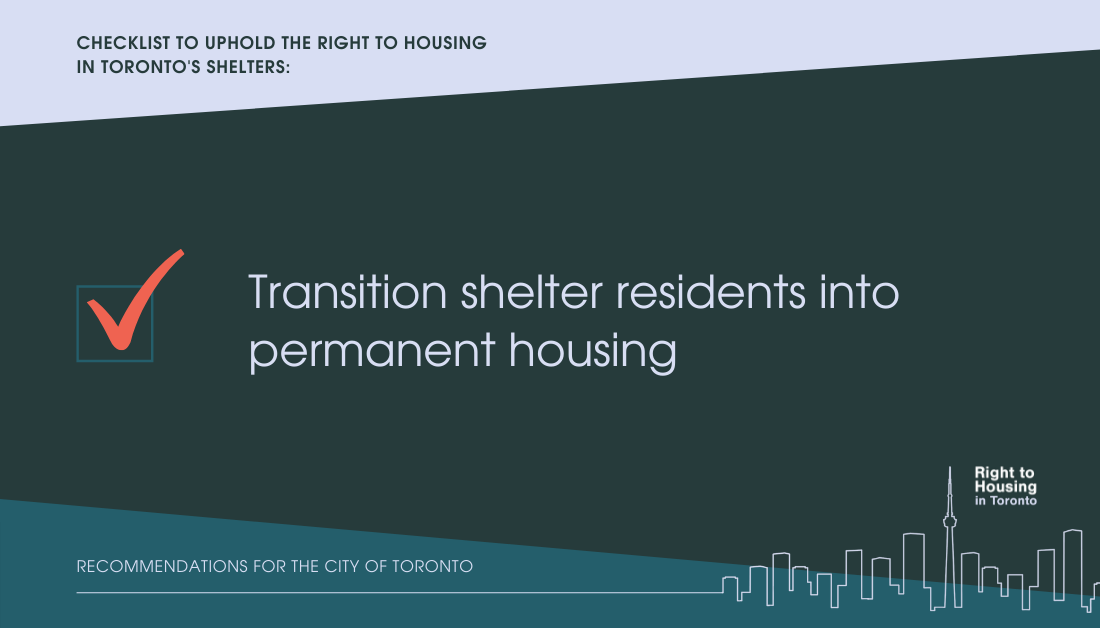The following key recommendations from our report Shelter Rights Review are aimed to improve the well-being, security and dignity of Toronto residents experiencing homelessness who temporarily live in emergency shelters. These recommendations are grounded in international human rights guidelines, and are designed to guide the City of Toronto in its efforts to advance the right to housing for all residents.
We invite advocates, groups and organizations to incorporate these recommendations into their own reports, policy proposals and submissions, calls to action, and meetings with elected officials and City staff to improve the lives of residents who use the shelter system or experience homelessness in Toronto.
Overall recommendations
The City of Toronto must:
-
-
- Implement the Office of the Housing Commissioner to advise the City on how to meet its human rights obligations, and to address systemic issues that lead to homelessness and violations of the right to housing within the shelter system.
- Ensure that the City’s shelter services, programs and policies are in alignment with advancing human rights and the right to housing.
- Meaningfully engage shelter residents in planning, reviewing and the decision-making processes to ensure that shelters are responsive to the diverse needs of all residents.
- Dedicate the maximum of the City’s available resources to provide safe, adequate and dignified housing options to residents who use the shelter system or experience homelessness.
-
Ten key recommendations
1. Provide shelter residents and people experiencing homelessness with a place where they can live in peace, and with security and dignity
The City of Toronto must:
-
-
-
- Prioritize the housing needs of the most marginalized residents and those in the most desperate circumstances.
- Provide shelter services that reflect and respect the individualized needs of residents and stakeholders.
- Plan for and invest in providing excess capacity in the shelter system.
- Identify or create adequate and appropriate temporary indoor shelter and permanent housing for encampment residents.
- Provide timely access to permanent, affordable housing options for shelter residents or people experiencing homelessness.
- Provide training for shelter staff and stakeholders to help shelter residents access income support programs, rent supplements, and support services.
- Explore ways to purchase short and long-term housing units with necessary supports that can be made available to shelter residents.
-
-
Download and share this graphic:
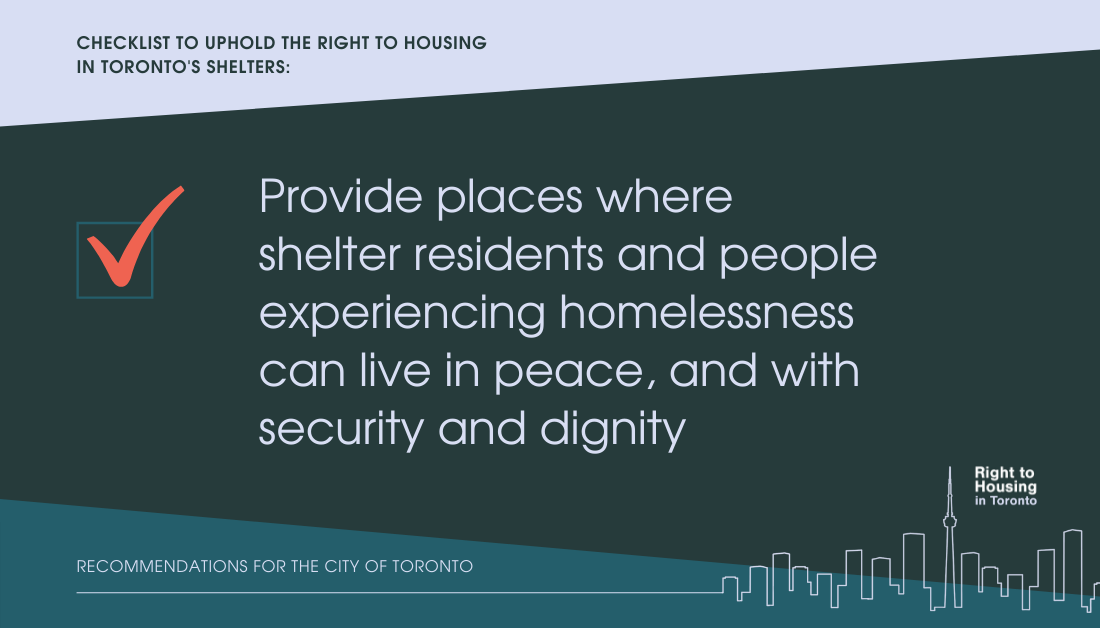
2. Protect shelter residents and people experiencing homelessness from involuntary relocation, removal, eviction, and a return to homelessness
The City of Toronto must:
-
-
- Take all necessary measures to consult with shelter residents and ensure they have access to alternative adequate accommodation when their relocation or discharge from emergency shelters is unavoidable.
- Allow encampment residents to remain where they are with access to necessary services including water, sanitation and food until safe and adequate indoor space is available.
-
The City of Toronto must not:
-
-
- Evict shelter residents into homelessness.
- Relocate or discharge shelter residents without their consent except in exceptional circumstances and where all alternatives have been explored in consultation with affected residents.
- Evict encampment residents from outdoor spaces.
- Forcibly relocate people experiencing homelessness to any indoor space that they deem is unsafe, inadequate for their needs, or that undermines their dignity.
-
Download and share this graphic:
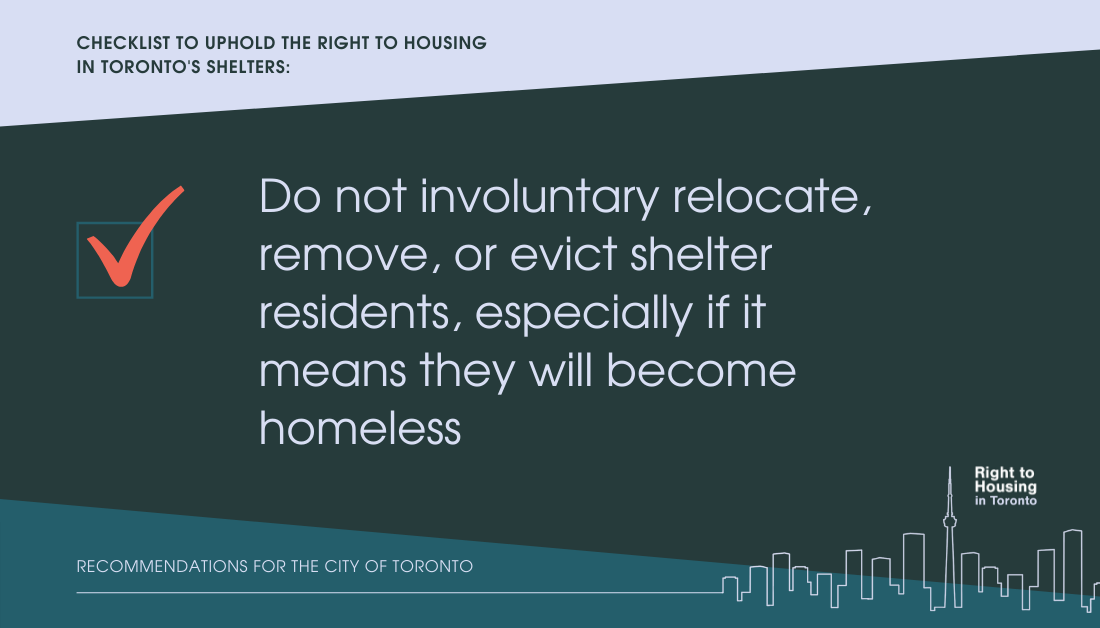
3. Ensure that shelters have adequate services and facilities that enable the health, dignity, security, privacy, comfort and nutrition of shelter residents
The City of Toronto must:
-
-
- Ensure that shelters are equipped with adequate sanitation facilities, including toilets, and provide access to sanitation products, including water, soap, sanitizers, harm reduction supplies, laundry and bathing facilities.
- Ensure that shelters allow for physical distancing and isolation during the pandemic, and if necessary, quarantine to control the spread of diseases.
- Provide shelter residents with information about health services that are available to them upon their arrival.
- Respond to the opioid crisis, including by expanding peer support and other harm reduction services across the shelter system, and updating its Harm Reduction Framework to reflect the realities of the crisis.
- Implement the Shelter Health Services Framework.
- Include appropriate psychological and social supports in physical and mental health services and facilities.
-
Download and share this graphic:
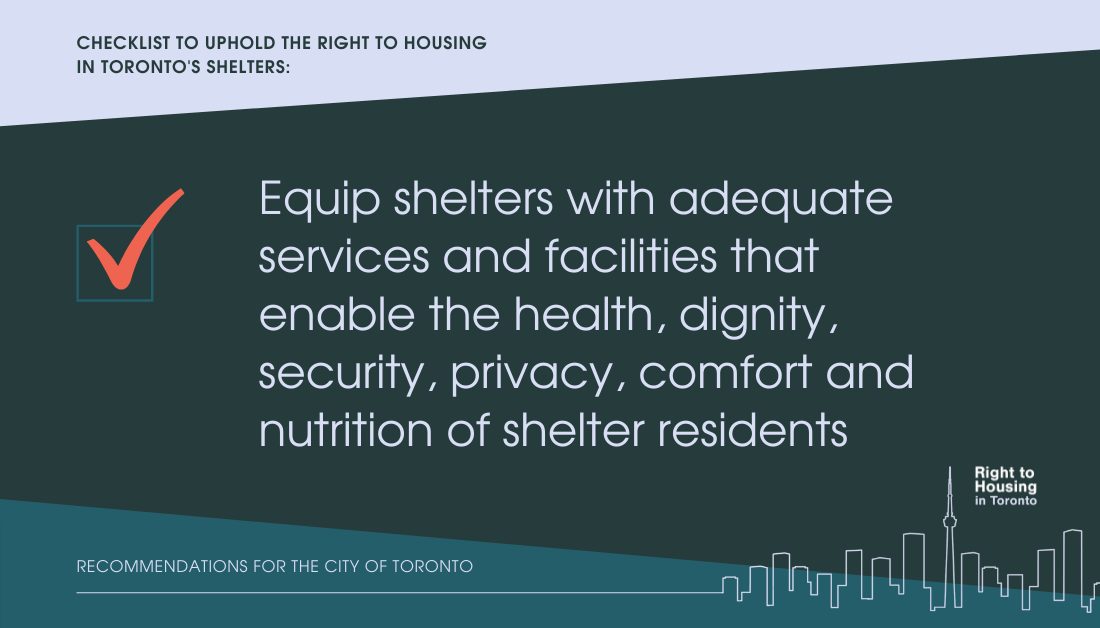
4. Provide a healthy and supportive environment for shelter residents and staff where they can be free from threats to their physical and mental health
The City of Toronto must:
-
-
- Ensure that shelters are safe for all residents’ physical, mental and emotional well-being.
- Ensure the entire shelter network and support services can be accessed and used without discrimination on any grounds, including migration status, nationality, gender, family status, health, sexual identity, age, ethnic origin, disability, dependence on alcohol or drugs, criminal record, or outstanding fines.
- Fully transition the shelter system away from congregate settings and prioritize personal space and privacy in new and renovated shelter accommodations.
- Provide people living with an addiction with access to harm reduction services and other programs to support their physical safety and health.
- Invest in a staffing model that provides an appropriate staff-to-client ratio.
-
Download and share this graphic:
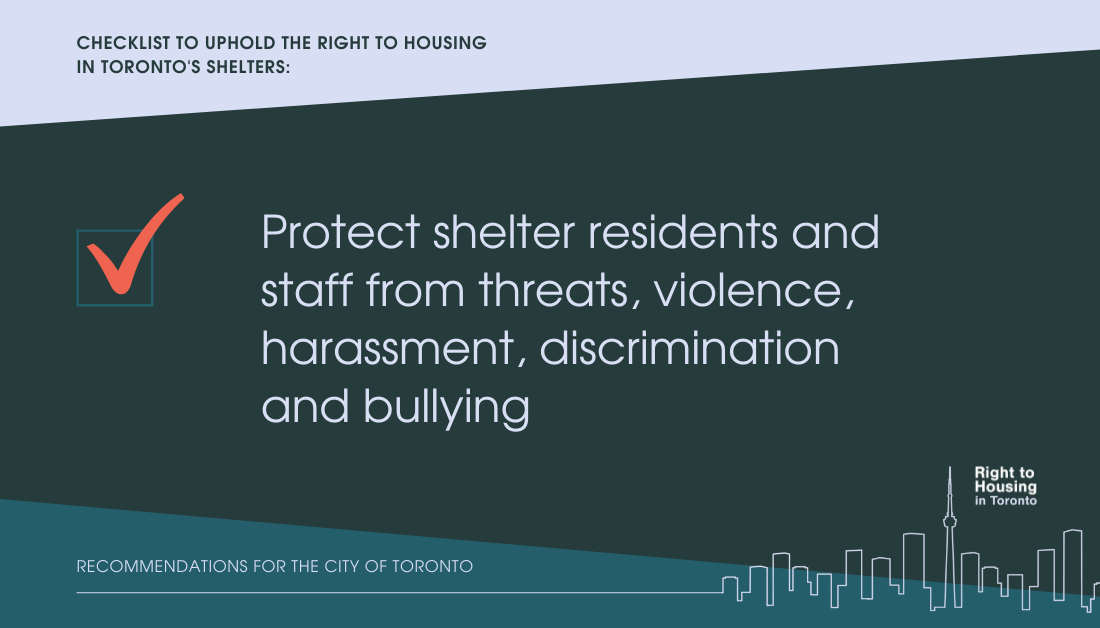
5. Equip the shelter system to accommodate the abilities and needs of all individuals
The City of Toronto must:
-
-
- Provide supportive environments for disadvantaged and marginalized communities such as LGBTQ2S+ and Indigenous residents.
- Accommodate the diverse needs of residents, in particular for marginalized groups such as women fleeing violence, trans-identifying and gender-diverse individuals, racialized groups, and Indigenous people.
- Accommodate the needs of persons with disabilities in a manner that ensures their dignity, including facilitating their ability to live independently and fostering their inclusion in all aspects of the shelter system.
- Ensure that the renovation or repurposing of existing infrastructure meets the needs of residents, including persons with disabilities.
- Accommodate the needs of residents with pets, where possible.
-
Download and share this graphic:
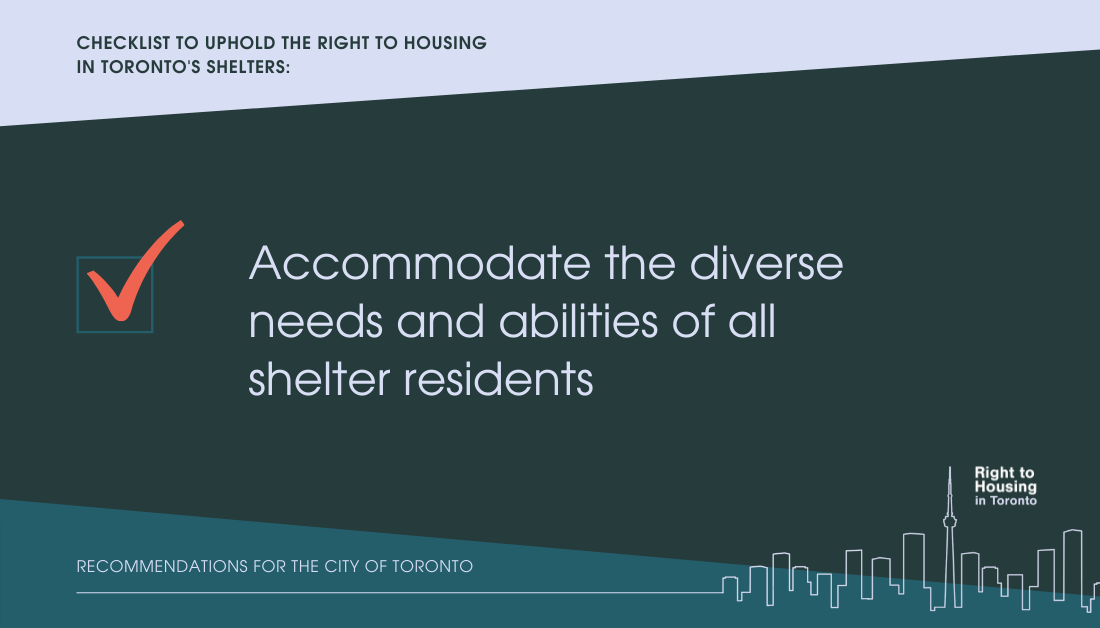
6. Ensure shelter residents have access to health care services, support networks, schools, childcare centres, and employment
The City of Toronto must:
-
-
- Ensure that shelters and housing opportunities are available for people throughout the city, not only in the downtown core, as well as services that residents rely on for their health and well-being.
- Ensure that social networks and communities (for example, residents of a particular encampment) can stay together when relocated to shelter spaces.
- Facilitate transportation for shelter residents so they can access shelters that are close to their networks and supports.
-
Download and share this graphic:
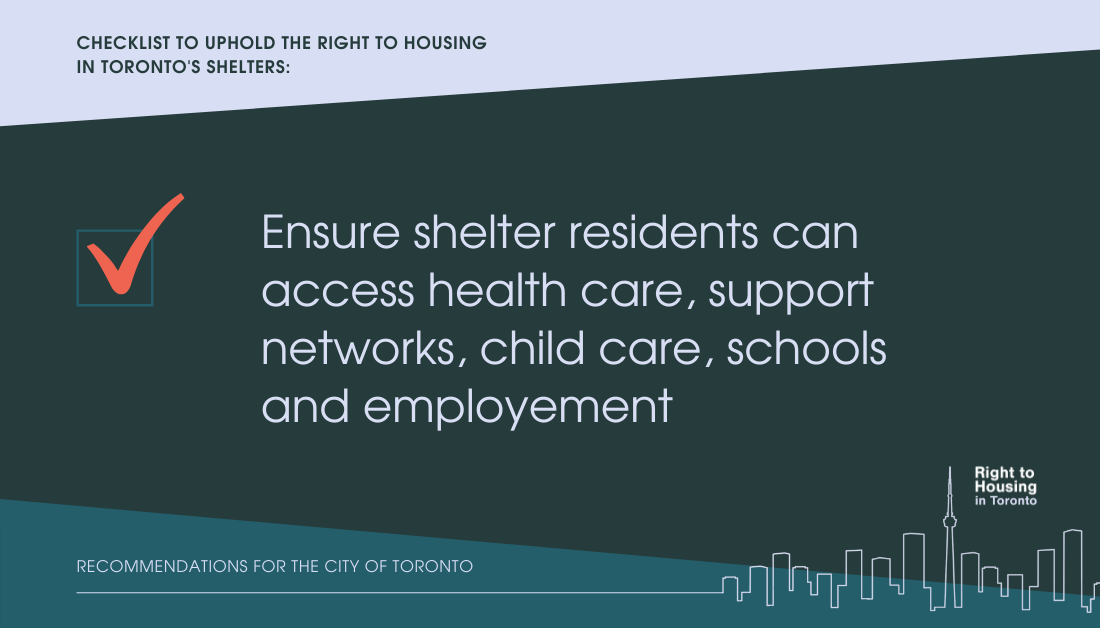
7. Ensure that the shelter system enables and supports the expression of cultural identity and diversity
The City of Toronto must:
-
-
- Use a trauma-informed and culturally-responsive approach in the construction, design and repurposing of shelters.
- Prioritize Indigenous-based ownership and operation of shelters and housing services that are intended for Indigenous populations.
- Ensure that all shelter providers operate from an anti-Black racism framework.
- Fully implement the recommendations in the Interim Shelter Recovery Strategy to address the disproportionate representation of Black and Indigenous individuals among the homeless population.
-
Download and share this graphic:

8. Meaningfully engage shelter residents in the design and implementation of all policies, programs and practices that affect them
The City of Toronto must:
-
-
- Include shelter residents in the design, construction, implementation and administration of shelter infrastructure and policies.
- Respond to feedback and input from shelter residents, and center their lived experience in the design, construction, development, redesign and renovation of shelter infrastructure.
-
Download and share this graphic:
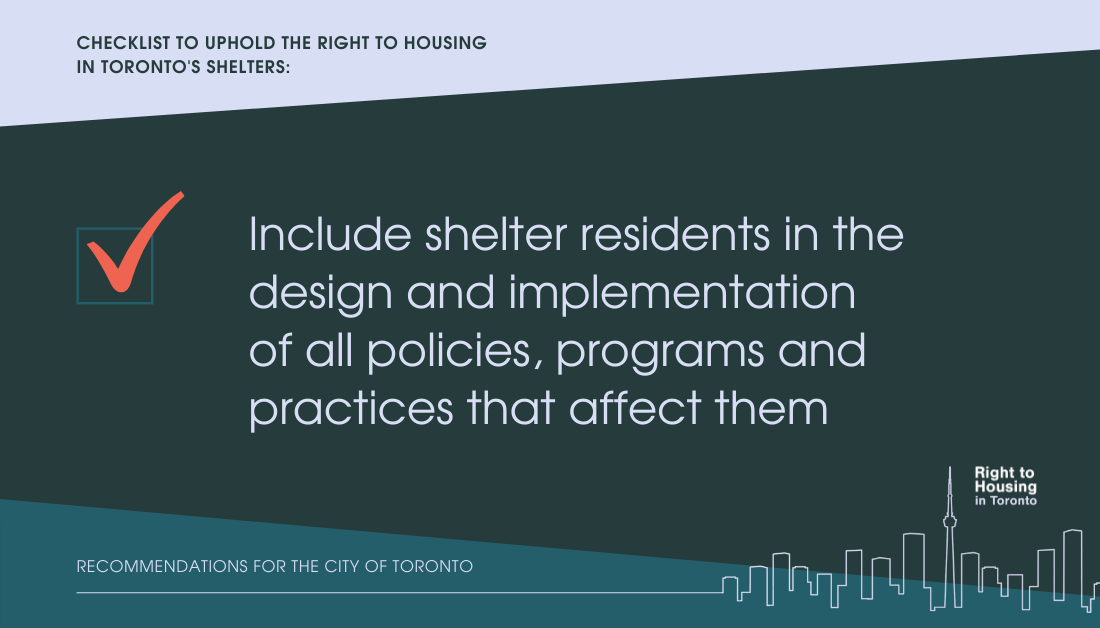
9. Ensure shelter residents have access to justice to claim their right to housing and other human rights
The City of Toronto must:
-
-
- Incorporate a rights-based approach so that residents can identify if their right to housing or other human rights have been violated.
- Ensure shelter residents have access to procedures where their human rights concerns can be fully heard, and through which necessary changes can be made.
- Provide shelter residents with information and access to legal aid services that can assist them with enforcing their legal rights.
- Develop a proactive education and outreach campaign for tenants to understand their legal rights through the eviction process, in order to prevent homelessness.
- Ensure tenants have access to eviction prevention services as soon as possible during the eviction process, including the funding of these services.
-
Download and share this graphic:
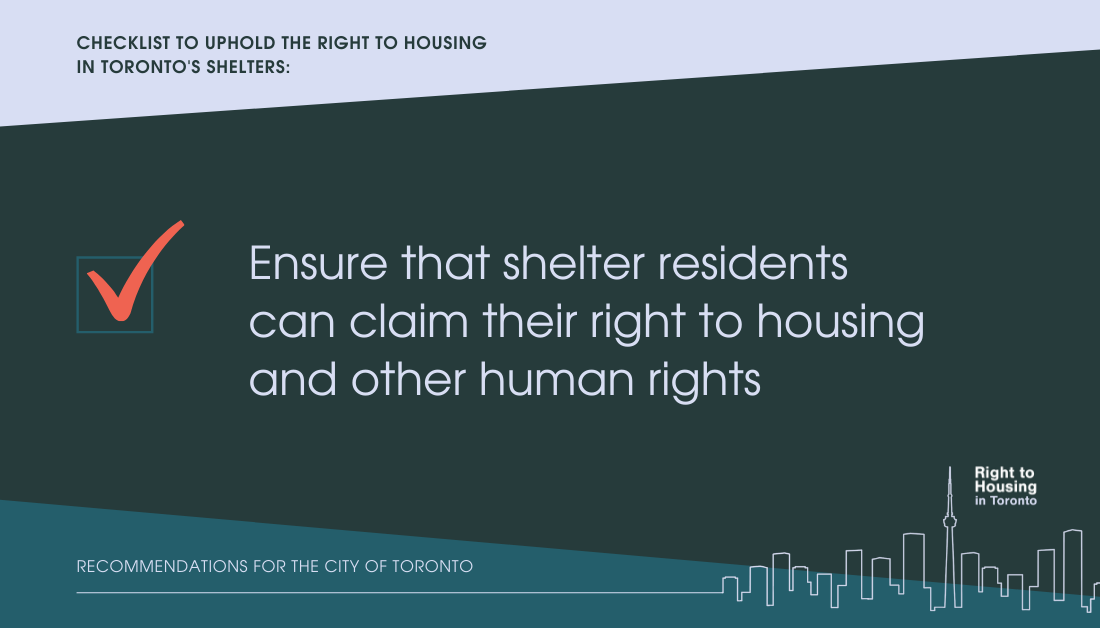
10. Implement comprehensive and rights-based policies, measures and strategies for transitioning shelter residents into permanent housing
The City of Toronto must:
-
-
- Prioritize the development of social, non-profit, rent-geared-to-income, supportive, and deeply affordable housing.
- Significantly invest in developing housing for the most vulnerable residents, those who are exiting the shelter system, and those who are at high risk of experiencing homelessness.
- Provide rent-geared-to-income subsidies for private rentals where appropriate non-profit housing is not available.
- Transition the existing shelter infrastructure into permanent and supportive housing, while ensuring emergency options are available for people who require short-term, safe and adequate shelter.
- Expand the availability of portable housing benefits, including the Toronto Housing Allowance Program (THAP), and designate THAP a permanent essential service.
- Support shelter staff by increasing the staff-to-client ratio, providing them with better education and training, better pay, and sick days.
- Transition shelter staff to a role that focuses on providing their clients with access to permanent and supportive housing opportunities.
-
Download and share this graphic:
